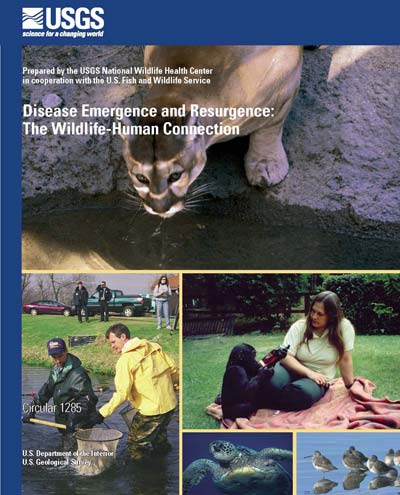|
The USGS National Wildlife Health Center is pleased to announce the publication of Circular 1285 -- Disease Emergence and Resurgence: The Wildlife-Human Connection. This book was prepared in cooperation with the U.S. Fish and Wildlife Service. Major funding support was provided by the U.S. Fish and Wildlife Service, Division of Federal Assistance, Administrative Grant No. AP95-017.
The book is available for download in Adobe pdf format. By downloading and printing each of these files, you can reproduce the entire Circular 1285. You will need to have Adobe Acrobat Reader installed on your system to read pdf files. (Adobe Acrobat Reader download site)
The complete book as a single zipped PDF is now available, (26MB download, right-click on the link and select "Save Target As..."/"Save Link As..." to save to your computer). The individual sections of the book are available below. (2-10 MB each)
|
|
 |
|
The USGS National Wildlife Health Center is proud to nominate the publication Disease Emergence and Resurgence: The Wildlife-Human Connection for a Blue Pencil Award in the soft-cover book category. This publication focuses on disease emergence in wildlife, the general importance of wild animals as sentinels for disease emergence, and critical issues regarding wildlife as sources for zoonotic disease (diseases transmissible between humans and animals). This publication’s content and writing style contribute to general public understanding of emerging and resurging wildlife disease; at the same time, it also addresses complex material and delves into scientific information useful for audiences with technical backgrounds.
This 400-page publication is rich in illustrations, photographs, informative tables, and history. Chapters include The Wildlife Factor, which speaks to how human actions unwittingly result in disease emergence and spread among wildlife populations; Zoonoses and Travel which details types of exposure people can experience with regard to zoonotic diseases (especially related to wildlife), and how people working with or encountering wildlife can discuss potential disease exposure with their health-care professionals. Is This Safe to Eat? clearly discusses risks associated with consuming fish and game, and ways to avoid these risks; Biowarfare, Bioterrorism, and Animal Diseases as Bioweapons is a complex chapter beginning with an historical account of disease emergence and leading to the potential that intentional use of wild animals as potential bioterrorism agents, and the problems that could arise is a possibility for which we all need to be aware. Lastly, How to Find and Access Published Information on Emerging Infectious Diseases is a thorough discussion of how to navigate the literature, both popular and scientific, related to zoonoses. Appendices include extensive tables related to chapter topics, and the book is indexed and includes a glossary.
This creative publication is designed to enhance public awareness of (a) the magnitude of disease emergence in free-living wildlife populations; (b) the importance of wildlife as a component of emerging zoonoses, and (c) the role of human actions and inactions in contributing to disease emergence and resurgence in wildlife. The target audience is broad, from the wildlife conservation community to the general public to college students taking courses in wildlife disease and public health. The requests for use of this publication speak to its success. It is being used for courses at the University of Maine and the University of Wisconsin; for youth hunter safety courses; many copies were requested for the Society for Conservation Biology Annual Conference and for a meeting of the Midwest Fish and Wildlife Committee. It is also being used by field staff at a number of regional wildlife health laboratories, at the South Carolina Department of Natural Resources, and by Congressional staffers. These are just some of the many agencies and organizations requesting copies of this publication. We have also received many letters and comments of praise from biologists, wildlife disease specialists, and agency administrators. The book received an excellent review (enclosed) by the Wildlife Management Institute, an organization associated with one of our primary target audiences.
If a reader were to peruse the book, and mainly review the illustrations, highlight boxes and tables, they would come away with a good grasp of the material, without having to read it cover to cover. These elements were designed to be the primary conveyors of major points. Also, each chapter contains extensive literature citations that lead serious students in the subject area and professionals in health science fields to pertinent sources for more detailed scientific information.
Approximate costs associated with this publication include the printing of 2,000 copies ($56,500), staff time and contractor costs, including work on illustrations and layout ($17,500). About 500 CDs were created at a nominal cost and many people (~700 according to the latest count) have downloaded the publication from the National Wildlife Health Center Web site.
|